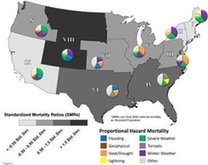美国研究人员近日发布了一份美国自然灾害“死亡地图”,显示高温比地震、山火、飓风等更易致人死亡。美国南卡罗来纳大学研究人员调查了全美1970年至2004年期间自然灾害致人死亡的相关案例,按照各种灾害对人的威胁程度制成这份“死亡地图”。在自然灾害导致死亡的人中,19.6%死于高温和干旱,18.8%死于夏季雷暴,18.1%死于冬季天气因素,只有不到5%死于地震、野外大火和飓风。
|

|
|
A handout graphic shows Proportional hazard Mortality and Standardized Mortality Ratios
|
Heat is more likely to kill an American than an earthquake, and thunderstorms kill more than hurricanes do, according to a "death map" published on Tuesday.
Researchers who compiled the county-by-county look at what natural disasters kill Americans said they hope their study will help emergency preparedness officials plan better.
Heat and drought caused 19.6 percent of total deaths from natural hazards, with summer thunderstorms causing 18.8 percent and winter weather causing 18.1 percent, the team at the University of South Carolina found.
Earthquakes, wildfires and hurricanes combined were responsible for fewer than 5 percent of all hazard deaths.
Writing in BioMed Central's International Journal of Health Geographics, they said they hoped to dispel some myths about what the biggest threats tolife and limb are.
"According to our results, the answer is heat," Susan Cutter and Kevin Borden of the University of South Carolina wrote in their report, which gathered data from 1970 to 2004.
"I think what most people would think, if you say what is the major cause of death and destruction, they would say hurricanes and earthquakes and flooding," Cutter said in a telephone interview. "They wouldn't say heat."
"What is noteworthy here is that over time, highly destructive, highly publicized, often-catastrophic singular events such as hurricanes and earthquakes are responsible for relatively few deaths when compared to the more frequent, less catastrophic such as heat waves and severe weather," they wrote.
The most dangerous places to live are much of the South, because of the heat risk, the hurricane coasts and the Great Plains states with their severe weather, Cutter said.
The south central United States is also a dangerous area, with floods and tornadoes.
California is relatively safe, they found.
"It illustrates the impact of better building codes in seismically prone areas because the fatalities in earthquakes have gone down from 1900 because things don't collapse on people any more," Cutter said.
"It shows that simple improvements in building codes in high-wind environments like hurricane coasts, and the effectiveness of evacuation in advance of hurricanes, has reduced the mortality from hurricanes and tropical storms," she added.
"So there are some things we are pretty good at in getting people out of harm's way and reducing fatalities."
Cutter said there is no national database on such deaths and this was a first try at getting one together.
(Agencies)

Vocabulary:
life and limb: continued existence or serious injury, 生命安危
(英语点津 Helen 编辑)